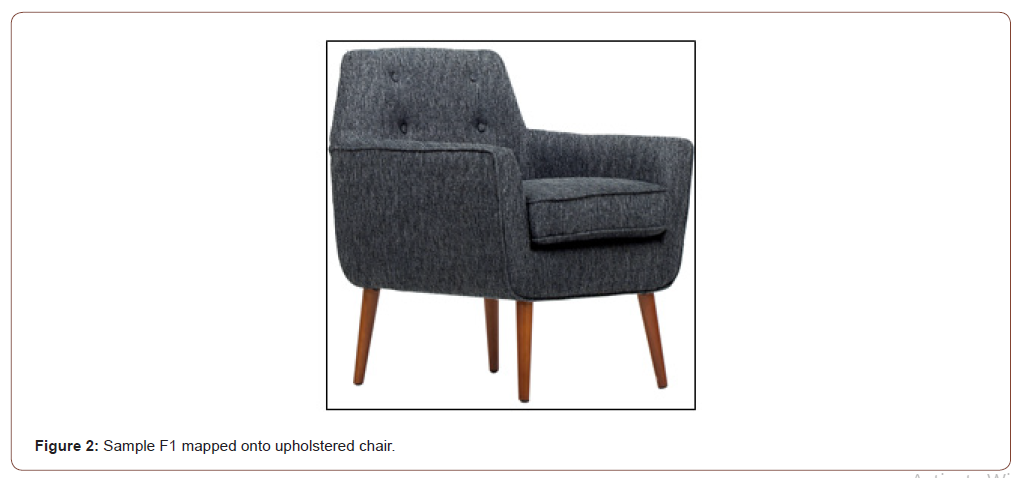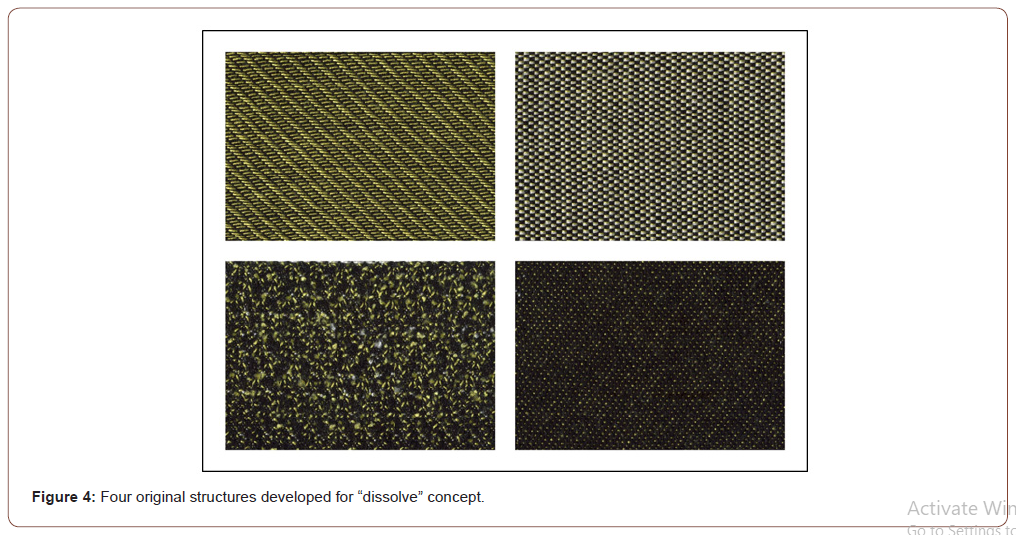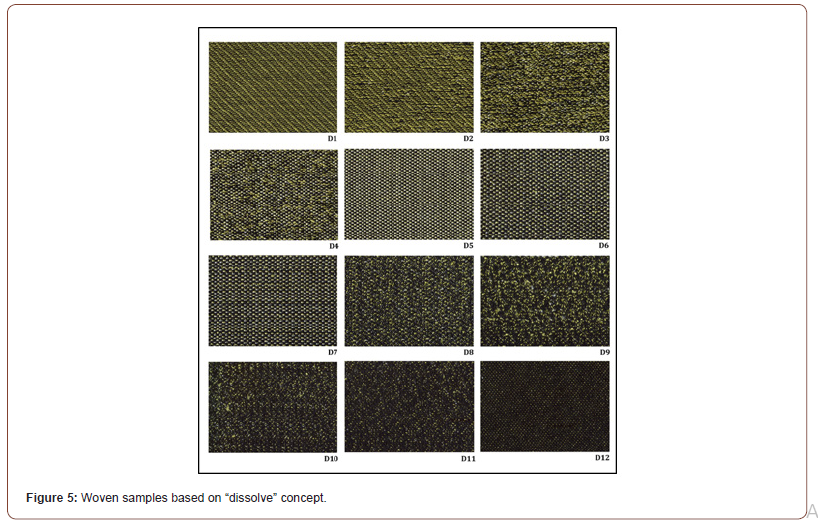 Research Article
Research Article
Focus and Dissolve: The Use of Cinematic Concepts in Developing Woven Textile Designs
Kate Nartker, Department of Textile and Apparel, Technology & Management, Wilson College of Textiles, North Carolina State University, USA.
Received Date: July 26, 2021; Published Date: August 09, 2021
Abstract
This paper examines an interdisciplinary approach to the textile design process via two case studies of woven pattern development. Through the use of cinematic concepts and motion graphics software, woven structures are designed for textile applications. The role of experimentation and inspiration sourcing is discussed with an emphasis on new uses for unconventional technologies. Due to the commonality of creative workflows in the fields of fashion and textile design, results of this analysis have application to a range of disciplines.
Keywords:Textile design; Jacquard weaving; Design process; Inspiration sourcing; Experimental design
Abbreviations:Adobe After Effects (AE)
Introduction
The creative process engaged in textile design involves a highly complex skill set that relies on concept development, technical knowledge, and a thorough understanding of design principles and color theory. Designers must source inspiration and use a range of hand and digital tools to methodically translate their ideas into unique designs and structures for knitted, woven, or non-woven fabrics.
Like most creative disciplines, the design process for textiles begins with visual research and the gathering of ideas. Designers look to nature, art, architecture, and other primary sources to gather inspiration for color, surface, structure, and pattern development. Research affirms the importance of inspirational sourcing as a means of developing content for designs, eliciting new ideas, and in supporting effective design management [1,2]. It has been found that the inspirational source contributes to not only the aesthetic outcome of a design, but also shapes the design process [1,3].
The development of new technological tools has offered advanced digital possibilities for reworking hand rendered techniques for textile design. An increasing number of CAD programs come with sophisticated capabilities in altering colorways, repeats, and simulating fabric structures. With each technological development, there is often an impact in the visual outcome of the textiles produced [4]. In the 1990s when advances in digital ink-jet printing technology were made widely available, Briggs noted a change in the visual characteristics and stylistic codes of printed textiles. He argued that the use of photography and digital imaging introduced a “new visual language” [5]. This was a result of not only the nature of the imagery, but also the complexity of layering and the visual vocabulary of color [6]. The same could be said for today’s accelerating developments. Advances in digital sketching tools have contributed to new textural and gestural effects [7], 3D printing is ushering in innovations in knit structures [8], and 3D virtual prototyping is improving the visualization and refinement of design concepts [9].
Today more and more designers are proficient in a wide range of CAD programs and accustomed to carrying out tasks in a digital landscape [10]. With advanced technological systems becoming integral in creative workflows, it is no surprise that technology itself is also serving as inspiration for contemporary textiles. In addition to its use as a production tool, digital technology is being approached as a medium itself to generate content for designs. For example, artist and designer Phillip David Stearns developed a line of jacquard woven blankets, scarves, and pillows entitled Glitch Textiles with patterns designed from data visualizations and malfunctioning technology [11]. Weaver Lia cook created a collection of woven works based on imaging tools and software used in a neuroscience laboratory [12]. Textile artist and educator Joevencio de la Paz designs woven content based on algorithms, self-generating patterns, and computational processes [13].
While each of these examples utilizes textile production methods, design content is sourced and developed from tools and technology outside of the field. An increasing number of textile artists are finding inspiration from unconventional uses of interdisciplinary technologies, but there is limited research on how experimental approaches can be applied to textile design. Unlike artists, designers work within production constraints and specific market contexts; however, the early design stage and creative development processes are similar and benefit from rigorous experimentation. As a result of exploratory investigations, a range of design samples can be developed and serve as the starting place for feedback on modifications and refinement [14].
In this study, an interdisciplinary approach is taken to source inspiration from techniques and tools used in filmmaking. The aim is to expand the textile design process by examining two case studies where unconventional technology is used to develop woven designs. In each case, cinematic techniques serve as the conceptual foundation and motion graphics software is utilized to create woven structures and patterns. By drawing upon an interdisciplinary approach, a divergent form of experimentation is conceived that can contribute to the ever-changing visual language of textiles today. The ultimate goal is to augment the creative design process by offering new possibilities to source, transform, and generate inspiration for textile design applications.
Conceptual Background
Filmmaking provides the conceptual background for this study as textiles have been interlaced with the history of cinema for centuries. Some of the earliest textiles embody the cinematic through experiential qualities, narrative, and form [15,16]. The Bayeux Tapestry from the 11th century, for example, is a sequential narrative that is heralded as being one of the most important works of pictorial art, related to the origins of cinematic narrative techniques [17].
There is also speculation that large textile works functioned as films, not only due to the narrative content, but also in the formal qualities of scale, reflection of light, and movement. Art critic and historian Arthur Danto discusses Raphael’s 16th century tapestries that hung in the Sistine Chapel and describes how the cloth achieved cinematic visual effects. In response to the surrounding environmental elements, there was a moment to moment interaction that gave a motility to woven images that would have been unavailable before the advent of the moving picture [16].
Textile artists and designers have also found parallels in the additive processes of filmmaking and textile construction techniques [18,19]. Just as traditional film is edited frame by frame, textiles are constructed pick by pick or stitch by stitch. There is an element of repetition and a sequential arrangement in each medium.
In the following case studies, two cinematic concepts were selected to provide a framework for developing woven patterns and structures: focus and dissolve. Focus involves the process of adjusting the lens of the camera to find maximum detail and sharpness in an image. In the post-production process of film editing, dissolve, sometimes referred to as lap dissolve, is used as a transition between scenes. Two scenes are overlapped for the duration of the effect with one image fading away while the next fades in [20].
“Focus” and “dissolve” provide a conceptual starting place here to develop a new process for generating textile designs. Rather than exclusively using CAD programs typically involved in woven textile design processes, motion graphics software is employed to develop varying structures. The translation from inspiration to content occurs within the film transitions when the patterns are being modified, leading to a new method of generating content for woven designs.
Case Studies
Focus
The aim in this case study was to develop a series of woven samples based on the same pattern, but with varying levels of detail and clarity. When viewed together, the pattern can be seen coming into focus, just as an opening scene would become legible in a film.
Table 1:Fabric specifications of woven samples.

A black and white pattern was first developed in Adobe Photoshop, and then uploaded into motion graphics software, Adobe After Effects (AE). AE is the industry standard tool for visual effects and motion graphics for film, TV, video, and web based moving images. Within the program, the camera tool was used to digitally blur the pattern and then bring it into focus within one second. A series of JPEG images from this sequence were exported at a frame rate of six frames per second. In other words, six images were exported that reveal the pattern slowly coming into focus. The images were then developed into files to be woven on a Thread Controller 2 (TC2) computerized Jacquard loom with a white 20/2 mercerized cotton warp and black 10/2 mercerized cotton weft. Each woven sample is 9 x 12 inches and can be seen in Figure 1. Fabric specifications can be seen in Table 1.

Like in filmmaking, the image, or in this case the pattern, gradually becomes clear. The final woven sample in the sequence is a graphic black and white design with a balanced woven structure. The first is a warp-faced structure with a faint pattern, while the intermediary samples have jagged edges as the black weft gradually becomes more prominent.
As a set, these samples offer the designer a range of options with subtle differences in textural and visual effects. Depending on the end use and product type, a bold, graphic design may be suitable, while in other cases a grainy, textural pattern is desired.
To visualize how this material would appear in a design application, sample F1 in Figure 1 is mapped onto an upholstered chair (Figure 2). From a distance, the pale pattern reads as a dark gray shade with a white textural overlay. The more defined patterns, F4 and F5, reveal optical, bold patterns appropriate for smaller items, such as accent pillows in Figure 3.


Dissolve
To create woven designs based on the film concept “dissolve”, the goal was to create a series of weavings that blend into one another. Four woven structures were developed in place of film scenes, which can be seen in Figure 4. The structures include a weft faced twill, basket weave, a textural structure with a large-scale repeat, and a warp faced twill.
To blend the patterns together, four placeholder JPEGs of solid colors were imported into AE. The dissolve transition effect was applied to each of the four solid colors, so that the sequence began with color one then faded into color two, which faded into three, then four. The transition of colors was exported into a JPEG sequence with a frame rate of six frames per second. The JPEGS were then arranged into a sequential grid in Photoshop as one combined file.
The file was then reduced to four colors, with each of the original four woven structures assigned to one color. In the transitional images, i.e. when one structure is fading into the next, two structures are mixed together with pixels dispersed in an automatically generated composition. The patterns are therefore broken up to create hybrid structures based on new configurations. The samples were woven on a 54” wide Dornier Rigid Rapier loom with Staubli JC5 Electronic Jacquard head and a black and white 20/1 cotton warp with a 15/1 cotton green and white weft. Select woven samples can be seen in Figure 5, and fabric specifications are listed in Table 1.


Unlike the weavings based on the “focus” concept, the samples here reveal a wide range of structures with varying levels of repetition. As one pattern dissolves into the next, there is a disruption of recognizable patterns. For instance, in sample D4 in Figure 5 the black and white basket weave is interrupted by the green weft from the previous structure, creating a mixed pattern with a defined repeat and interlacing floats. With the longer green yarns intertwined throughout the geometric black and white basket weave structure, a varied, textural surface is created. This can be seen again in sample D11 in Figure 5. A composite pattern is created that contains a seemingly random repeat with a faint diagonal twill structure emerging.
While the pattern differences are subtle, the impact is significant when applied to a textile design application. As seen in Figure 6, the minor variations result in a considerable range of textural and visual outcomes. This approach could be useful in developing collections with coordinating designs that offer distinct contrast and variability.
Conclusion
This study offers an experimental approach to the textile design process. In each case study, there is an element of chance as weave structures are created as a result of cinematic transitions. While this process was applied to woven structures, a similar approach could be used in the development of new motifs, colorways, or compositions.
More importantly, however, this research exemplifies how technology can be used as a creative medium rather than a production tool. By exploring interdisciplinary processes and technologies, an indefinite number of new concepts and imagery can be generated, contributing to new design expressions in textiles.
Balancing experimentation with production and commercial market constraints is a challenge all designers face. While it may not be feasible to utilize unconventional design tools in all cases, it is essential to recognize that the testing of new processes is helpful in developing innovative designs. Purposeful investigations and an inquiry into divergent design methods can contribute to new aesthetic outcomes and expansive visual vocabularies for textile design applications.
Acknowledgement
None.
Conflict of Interest
Author declares no conflict of interest.
References
- Strickfaden M, Stafiniak L, Terzin T (2015) Inspired and Inspiring Textile Designers. Clothing and Textiles Research Journal 33(3): 213-228.
- Eckert C (1997) Design Inspiration and Design Performance. Proceedings of the 78th World Conference of the Textile Institute.
- Eckert C, Stacey M (2000) Sources of inspiration: A language of design. Design Studies 21: 523-538.
- Bunce, G (1994) The Effects of Technological Developments on Pattern Structures used in Printed Textiles. Ars Textrina 22: 129–62.
- Briggs A (1997) A Study of Photographic Images, Processes and Computer Aided Textile Design. PhD thesis, Nottingham Trent University, Nottingham, UK.
- Treadaway C (2004) Digital Imagination: The Impact of Digital Imaging on Printed Textiles. TEXTILE, 2(3): 256-273.
- Annum GY (2014) Digital painting evolution: A multimedia technological platform for expressivity in fine art painting. Journal of Fine and Studio Art 4(1): 1-8.
- Chatterjee K, Ghosh TK (2019) 3D Printing of Textiles: Potential Roadmap to Printing with Fibers. Advanced Materials 32(4): 1902086.
- Papahristou E, Bilalis N (2017) 3D Virtual Prototyping Traces New Avenues for Fashion Design and Product Development: A Qualitative Study. Journal of Textile Science & Engineering 7(2): 1-6.
- Granger MM (2015) The Fashion Industry and Its Careers: An Introduction (3rd edn), Fairchild Books, pp. 32-33.
- Stearns PD (2021) Glitch textiles Collection. Glitch Textiles.
- Cook L (2021) Lia Cook: New Works.
- de la Paz J (2021) The ghost and the maze.
- Studd R (2002) The Textile Design Process. The Design Journal 5(1): 35-49.
- Randles S (2009) The Guicciardini Quilts. Medieval Clothing and Textiles Woodbridge 5:103-127.
- Danto A (2002) Reflections on fabric and meaning. In M. Boulton Stroud (Edt), New material as new meaning: The fabric workshop and museum. Philadelphia: The Fabric Workshop Museum, pp. 82-89.
- Noxon, G (1968) The Bayeux Tapestry. Cinema Journal 7: 29-35.
- Gschwandtner S (2021) Film Quilts.
- Wilson A (2008) Topologies.
- (2021) Dictionary of Film Terms: The Aesthetic Companion to Film Art – Common, Peter Lang Publishing Inc.
-
Kate Nartker. Focus and Dissolve: The Use of Cinematic Concepts in Developing Woven Textile Designs. 9(1): 2021. JTSFT. MS.ID.000702.
-
Textile design, Jacquard weaving, Design process, Inspiration sourcing, Experimental design
-

This work is licensed under a Creative Commons Attribution-NonCommercial 4.0 International License.






